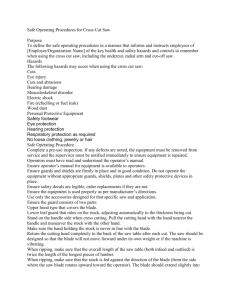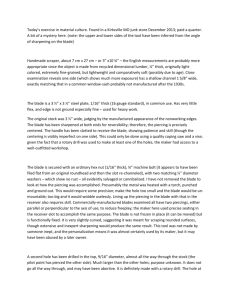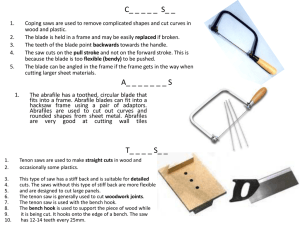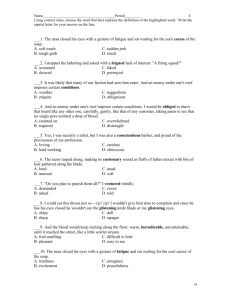Blade Changing Procedure - Technician Support Service
advertisement
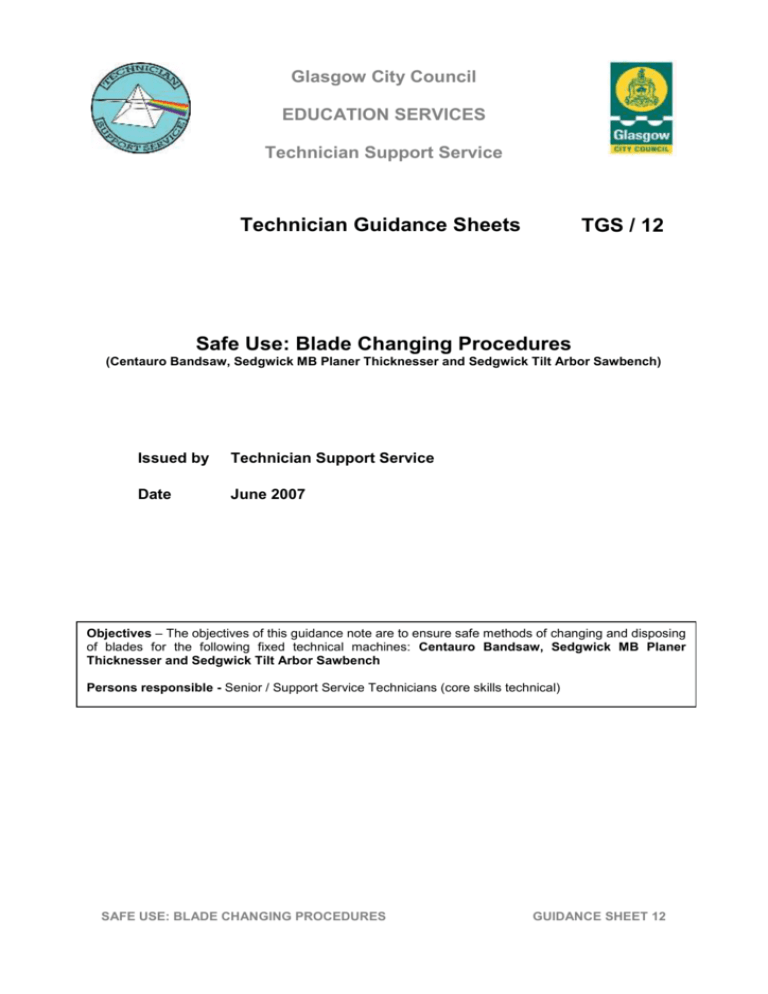
Glasgow City Council EDUCATION SERVICES Technician Support Service Technician Guidance Sheets TGS / 12 Safe Use: Blade Changing Procedures (Centauro Bandsaw, Sedgwick MB Planer Thicknesser and Sedgwick Tilt Arbor Sawbench) Issued by Technician Support Service Date June 2007 Objectives – The objectives of this guidance note are to ensure safe methods of changing and disposing of blades for the following fixed technical machines: Centauro Bandsaw, Sedgwick MB Planer Thicknesser and Sedgwick Tilt Arbor Sawbench Persons responsible - Senior / Support Service Technicians (core skills technical) SAFE USE: BLADE CHANGING PROCEDURES GUIDANCE SHEET 12 Safe Use: Blade Changing Procedure 1 AIMS AND OBJECTIVES 1.1 Aims To instruct technician staff in the safe methods of changing the blades on the following machines: Centauro Bandsaw, Sedgwick MB/CP Planer Thicknesser and the Sedgwick TA315 Tilt Arbor Sawbench. 1.2 Objectives 1.2.1 Know and understand the hazards associated with blade changing procedures 1.2.2 Know what personal protective equipment is mandatory when changing blades 1.2.3 Know the necessary tools and equipment required to carry out this procedure 1.2.4 Know and understand the correct and safe procedures for changing blades for all three machines 1.2.5 Know and recognise the correct blade type to be used for each machine 1.2.6 Know to examine blades before fitting to ensure they are not damaged 1.2.7 Demonstrate the blade replacement procedure for all three machines 1.2.8 Know the procedure for safe disposal of used / damaged blades 1 2 CENTAURO BANDSAW 2.1 Personal Protective Equipment: Goggles (BSEN-166-349B), Riggers Protective Gloves 2.2 Tools required: 3mm, 4mm and 5mm Hexagonal Keys, 13mm Spanner 2.3 Procedure: 2.3.1 Ensure that the blade being fitted is suitable for the bandsaw. 2.3.2 Isolate the Bandsaw from the power supply and padlock the isolator, retain the padlock key. 2.3.3 Extend and rotate the perspex blade guard 180 degrees, to expose the blade 2.3.4 Using the 5mm hexagonal key, remove the capped screws from the upper and lower access doors. 2.3.5 Open the upper and lower access doors, to expose the blade and the pulley wheels. 2.3.6 Open the lower blade guides cover and remove the "dust deflector" board. 2 2.3.7 Release the tension on the blade by turning the blade tension hand wheel anti clockwise. 2.3.8 While wearing protective gloves and goggles slide the blade off the upper and lower flywheels, guide it through the slot in the telescopic blade guard and the slot in the main column of the machine. 2.3.9 If disposing of a worn or damaged blade: fold the blade at least three times and tape it together using gaffa tape. Store the blade along with department scrap metal for disposal. (See Fig 1.1 - 1.4) Safe Method of Folding A Bandsaw Blade for Disposal Fig 1.1 Fig 1.2 Fig 1.3 Fig 1.4 3 If the blade has to be retained for future use: it should be folded in a spiral fashion, taped and stored safely for future use. (See Fig 2.1 - 2.3) Fig 2.2 Fig 2.1 Fig 2.3 4 2.3.10 Carefully uncoil the new blade and inspect it for damage. or damaged teeth. DO NOT FIT A DAMAGED BLADE Check for any cracks, kinks 2.3.11 Offer the blade up to the machine and ensure that the teeth are running in the correct direction. 2.3.12 Guide the blade through the slot in the telescopic blade guard and the slot in the main column of the machine. 2.3.13 Place the blade over the top and bottom flywheels and carefully position between the upper and lower blade guides. 2.3.14 If fitting a ⅜ inch or ½ inch blade (10mm or 12mm), it should be positioned in the centre of the flywheel. However, if fitting a 1 inch blade (25mm) then you must ensure that the teeth protrude over the edge of the flywheel to eliminate any wear on the flywheel tyre. (See Fig 3.1 - 3.2) Fig 3.1 ⅜ inch or ½ inch blade Fig 3.2 1 inch blade 2.3.15 Tension the blade using the blade tensioning handwheel, the tension should be checked at the tension gauge. 2.3.16 Remove the padlock and energise the bandsaw, this will be indicated by the power indicator on the control panel at the front of the bandsaw. 2.3.17 While depressing the yellow brake deactivation button, turn the top flywheel and observe the tracking of the blade. If there is any movement of the blade along the flywheel then you must adjust the cant of the wheel. The cant is adjusted by turning the flywheel tilt handle in the appropriate direction. 2.3.18 Once the blade is set, lock the flywheel tilt handle and replace the dust deflector. 2.3.19 Check and adjust, if necessary, the upper and lower blade guides and thrust wheels and close the lower blade guides cover. 2.3.20 Close and lock the access doors. 2.3.21 Finally, run the bandsaw and test for safe operation. 5 3 SEDGWICK TA315 TILT ARBOR SAWBENCH 3.1 Personal Protective Equipment: Goggles (BSEN-166-349B), Riggers Protective Gloves 3.2 Tools required: 13mm Spanner, 30mm Spanner, Spindle Locking Handle, Flat Blade Screwdriver (12mm) and a Cleaning Rag 3.3 Procedure: 3.3.1 Ensure that the blade being fitted is suitable for the circular saw (only 12 inch or 315mm). 3.3.2 Isolate the Circular Saw from the power supply and padlock the isolator (attach a “do not operate” sign), retain the padlock key. 3.3.3 Raise the saw blade to its highest point. 3.3.4 Using the 13mm spanner, release the crown guard and lift it clear of the blade. (See Fig 4.1) Fig 4.1 3.3.5 Using the flat blade screwdriver, remove the table insert. (See Fig 4.2) Fig 4.2 6 3.3.6 Turn the blade by hand until the spindle locking hole is exposed on the saw spindle. 3.3.7 Insert the spindle lock into the locking hole. (See Fig 5.1) Fig 5.1 3.3.8 With the spindle locking handle located firmly in place, use the 30mm spanner and loosen the blade securing nut in a clockwise direction. (See Fig 5.2) Fig 5.2 3.3.9 Remove the blade securing nut and the loose saw collar. 7 3.3.10 While wearing protective gloves and goggles, carefully remove the saw blade. 3.3.11 Using the cloth rag, clean both saw collars to remove any dust or resin. 3.3.12 Ensure that the saw blade being fitted is clean and sharp. 3.3.13 Place the new blade onto the spindle, ensuring that the direction of rotation is correct, and line up the locating hole to the drive pin. 3.3.14 Replace the loose saw collar and the blade securing nut. Screw the nut on finger tight. 3.3.15 Using the 30mm spanner, tighten the securing nut by hand in an anti-clockwise direction while holding the spindle locking handle. Never strike the spanner with a hammer to tighten the securing nut as this could damage the saw blade. 3.3.16 Remove the spindle locking handle. 3.3.17 Check the alignment of the riving knife: The riving knife should be adjusted so that at table level the distance between the front of the knife and the saw teeth does not exceed 8mm and its arc follows that of the saw blade. 3.3.18 Replace the table insert: Secure in place and adjust so that it is level with the saw table. 3.3.19 Re-set the crown guard: The crown guard should be adjusted so that it is parallel with the saw table. 3.3.20 Lower the saw blade to its lowest position. 3.3.21 Finally, run the circular saw and test for safe operation Note Saw blades should be sharpened and/or re-toothed by a reputable agency e.g. The Saw Centre Circular saw blades should be disposed of along with scrap metal. 8 4 SEDGWICK MB/CP PLANER / THICKNESSER 4.1 Personal Protective Equipment: Goggles (BSEN-166-349B), Riggers Protective Gloves 4.2 Tools required; Mallet, Brass Dolly and Marker Pen 4.3 Procedure: 4.3.1 Ensure that the blades being fitted are suitable for the planer thicknesser: double sided tersa cutters (tersa cutters must not be re-sharpened). 4.3.2 Isolate the planer thicknesser from the power supply. 4.3.3 If necessary remove the extraction hood to expose the cutter block. 4.3.4 Adjust the bridge guard clear of the cutter block. 4.3.5 Using the marker pen, number the first blade (1). (See Fig 6.1) Fig 6.1 4.3.6 Using the mallet and brass dolly, gently tap each of the three locking clamps to release the blade. Be careful not to hit the blades.(See Fig 6.2) Fig 6.2 9 4.3.7 Using the brass dolly, carefully slide the blade out towards you. Finally remove the blade. (See Fig 7.1 - 7.2) Fig 7.1 Fig 7.2 4.3.8 4.3.9 Either turn the blade over and slide back into place, or replace with a new blade. Align the edge of the blade with the edge of the cutter block and slowly slide the blade into place. Replace the blade guard to cover the cutter block. 4.3.10 Energise the planer thicknesser, stand clear and switch on. Centrifugal force will throw the locking clamps forward and automatically tighten the blades. 4.3.11 Deactivate the brake. 4.3.12 Remove the blade guard, and turn the cutter block by hand to the next unmarked blade and number it (2). 4.3.13 Isolate the planer thicknesser. 4.3.14 Repeat from steps 4.3.6 for blades 2, 3 and 4. 4.3.15 When all the blades have been replaced, run the planer thicknesser and test for safe operation. Note To dispose of used / damaged planer blades, wrap blades in an old rag and break with a hammer. Appropriate PPE must be worn i.e. goggles and protective gloves. Dispose of broken blade parts in scrap metal bin. 10


